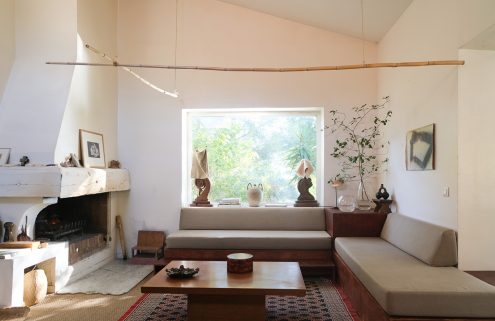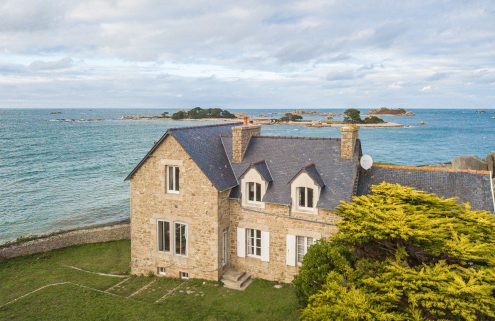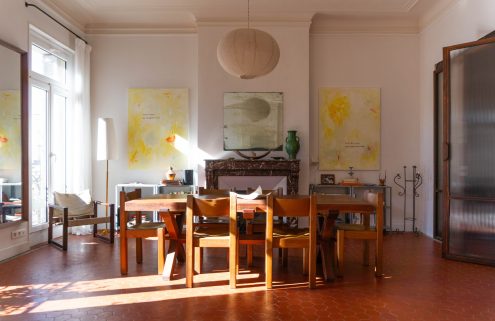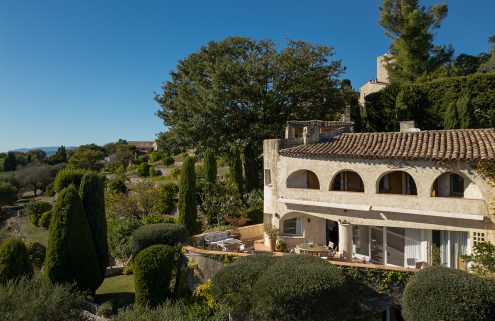France’s churches are awe-inspiring spaces, built across the centuries to honour the divine while forming the cornerstone of community life.
These places of worship have character in abundance while some are works of art in their own right. As such, many are reborn as homes, with their soaring volumes, vaulted ceilings, and handcrafted joinery making impressive backdrops for living spaces and bedrooms.
We’ve found five former churches for sale across France that are perfectly intact – or have been converted into homes where their features shine. They include an all-iron prototype in Lorraine and a wildly colourful abode on Brittany’s emerald coast.
Take a peek at these heavenly homes.

A colourful church in Dinard, Brittany
€950,000
Located along France’s emerald coast, this aisleless Anglican church conversion brims with eccentricity, bright hues, stained pitch pine and a repeating pointed arch motif. The gothic Dinard home has saffron walls, a double staircase, a mezzanine bedroom, and two metal chandeliers. It was built in 1877 and turned into a shop in 1906, named le Grand Bazar des Nouvelles Galeries.

A colourful church in Dinard, Brittany
€950,000
Located along France’s emerald coast, this aisleless Anglican church conversion brims with eccentricity, bright hues, stained pitch pine and a repeating pointed arch motif. The gothic Dinard home has saffron walls, a double staircase, a mezzanine bedroom, and two metal chandeliers. It was built in 1877 and turned into a shop in 1906, named le Grand Bazar des Nouvelles Galeries.

A colourful church in Dinard, Brittany
€950,000
Located along France’s emerald coast, this aisleless Anglican church conversion brims with eccentricity, bright hues, stained pitch pine and a repeating pointed arch motif. The gothic Dinard home has saffron walls, a double staircase, a mezzanine bedroom, and two metal chandeliers. It was built in 1877 and turned into a shop in 1906, named le Grand Bazar des Nouvelles Galeries.

A colourful church in Dinard, Brittany
€950,000
Located along France’s emerald coast, this aisleless Anglican church conversion brims with eccentricity, bright hues, stained pitch pine and a repeating pointed arch motif. The gothic Dinard home has saffron walls, a double staircase, a mezzanine bedroom, and two metal chandeliers. It was built in 1877 and turned into a shop in 1906, named le Grand Bazar des Nouvelles Galeries.

Art deco church near Péronne, Hauts-de-France
Near the Somme battlefields, this concrete, brick and stone modernist 1932 church was built on the site of an 11th-century church destroyed during the First World War. Though art deco in style, it feels like a much older building inside, with its square vaulted ceiling and pale exposed beams which resemble a ship’s hull. There’s a semi-circular barrel vault with faded renaissance-style frescos and no side aisles, which is impressive due to its size.

Art deco church near Péronne, Hauts-de-France
Near the Somme battlefields, this concrete, brick and stone modernist 1932 church was built on the site of an 11th-century church destroyed during the First World War. Though art deco in style, it feels like a much older building inside, with its square vaulted ceiling and pale exposed beams which resemble a ship’s hull. There’s a semi-circular barrel vault with faded renaissance-style frescos and no side aisles, which is impressive due to its size.

Art deco church near Péronne, Hauts-de-France
Near the Somme battlefields, this concrete, brick and stone modernist 1932 church was built on the site of an 11th-century church destroyed during the First World War. Though art deco in style, it feels like a much older building inside, with its square vaulted ceiling and pale exposed beams which resemble a ship’s hull. There’s a semi-circular barrel vault with faded renaissance-style frescos and no side aisles, which is impressive due to its size.

A 19th-century stone chapel in Quimper, Brittany
€690,000 via Patrice Besse
Concentric arches lead the eye to the altar inside this granite seminary and chapel in Brittany, illuminated by coloured light from windows featuring Breton saints. Fascinatingly, in 1933, it was dismantled and reassembled stone by stone in the location of a larger seminary. Now it is used as a cultural centre and has commercial potential as a hotel or catering premises.

A 19th-century stone chapel in Quimper, Brittany
€690,000 via Patrice Besse
Concentric arches lead the eye to the altar inside this granite seminary and chapel in Brittany, illuminated by coloured light from windows featuring Breton saints. Fascinatingly, in 1933, it was dismantled and reassembled stone by stone in the location of a larger seminary. Now it is used as a cultural centre and has commercial potential as a hotel or catering premises.

An iron church in Crusnes, Grand Est
This all-iron Crusnes prototype church was built in 1937 in art deco style, to a prefabricated design, which had a planned roll-out in France’s African colonies. Due to the Second World War, it became a unique structure and later a symbol of Lorraine’s steel basin. It has a light-grey, sheet metal structure lit by modern stained-glass designs showcasing religious figures and geometric shapes.

An iron church in Crusnes, Grand Est
This all-iron Crusnes prototype church was built in 1937 in art deco style, to a prefabricated design, which had a planned roll-out in France’s African colonies. Due to the Second World War, it became a unique structure and later a symbol of Lorraine’s steel basin. It has a light-grey, sheet metal structure lit by modern stained-glass designs showcasing religious figures and geometric shapes.

An iron church in Crusnes, Grand Est
This all-iron Crusnes prototype church was built in 1937 in art deco style, to a prefabricated design, which had a planned roll-out in France’s African colonies. Due to the Second World War, it became a unique structure and later a symbol of Lorraine’s steel basin. It has a light-grey, sheet metal structure lit by modern stained-glass designs showcasing religious figures and geometric shapes.

An iron church in Crusnes, Grand Est
This all-iron Crusnes prototype church was built in 1937 in art deco style, to a prefabricated design, which had a planned roll-out in France’s African colonies. Due to the Second World War, it became a unique structure and later a symbol of Lorraine’s steel basin. It has a light-grey, sheet metal structure lit by modern stained-glass designs showcasing religious figures and geometric shapes.

A 16th-century former cloister in Albi, Occitanie
€1.2m
Built in typical Albi style in brick and stone, this remodelled 16th-century, two-level cloister has a quadrilateral gallery, set around a garden. To create the home, mirrored glass walls have been inserted between the arches to form living spaces that are hidden from the central space but have views out. It has a modern monastic-style aesthetic, open-plan rooms, and a pitched roofed art studio/gallery space.

A 16th-century former cloister in Albi, Occitanie
€1.2m
Built in typical Albi style in brick and stone, this remodelled 16th-century, two-level cloister has a quadrilateral gallery, set around a garden. To create the home, mirrored glass walls have been inserted between the arches to form living spaces that are hidden from the central space but have views out. It has a modern monastic-style aesthetic, open-plan rooms, and a pitched roofed art studio/gallery space.
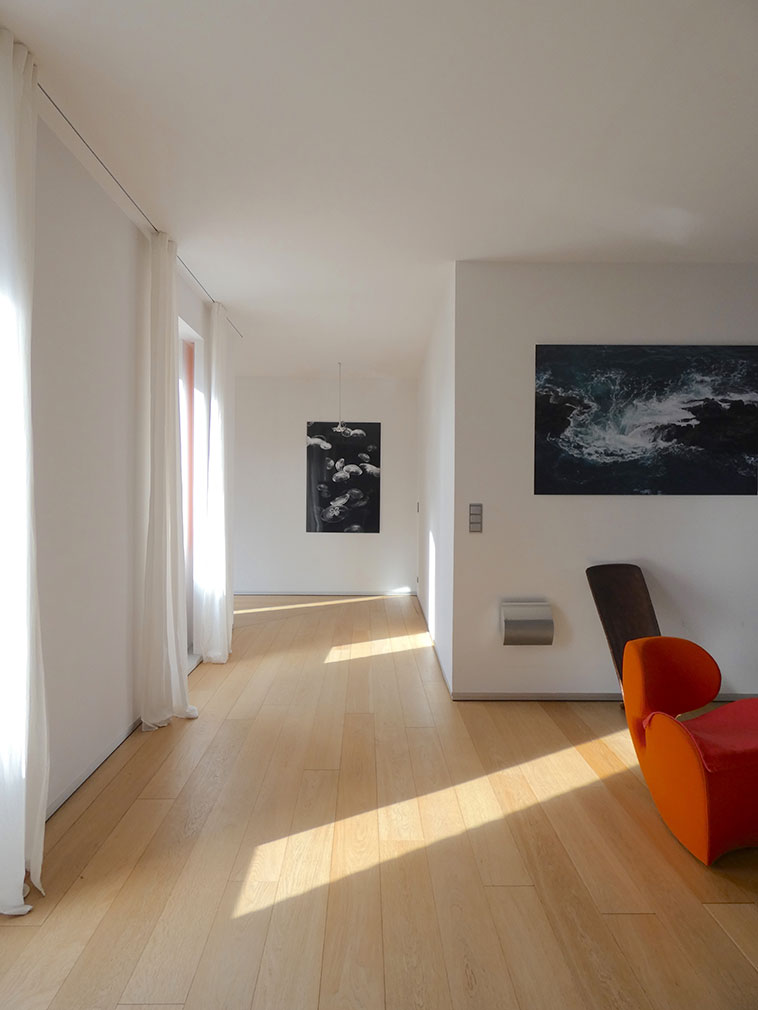
A 16th-century former cloister in Albi, Occitanie
€1.2m
Built in typical Albi style in brick and stone, this remodelled 16th-century, two-level cloister has a quadrilateral gallery, set around a garden. To create the home, mirrored glass walls have been inserted between the arches to form living spaces that are hidden from the central space but have views out. It has a modern monastic-style aesthetic, open-plan rooms, and a pitched roofed art studio/gallery space.

A 16th-century former cloister in Albi, Occitanie
€1.2m
Built in typical Albi style in brick and stone, this remodelled 16th-century, two-level cloister has a quadrilateral gallery, set around a garden. To create the home, mirrored glass walls have been inserted between the arches to form living spaces that are hidden from the central space but have views out. It has a modern monastic-style aesthetic, open-plan rooms, and a pitched roofed art studio/gallery space.
